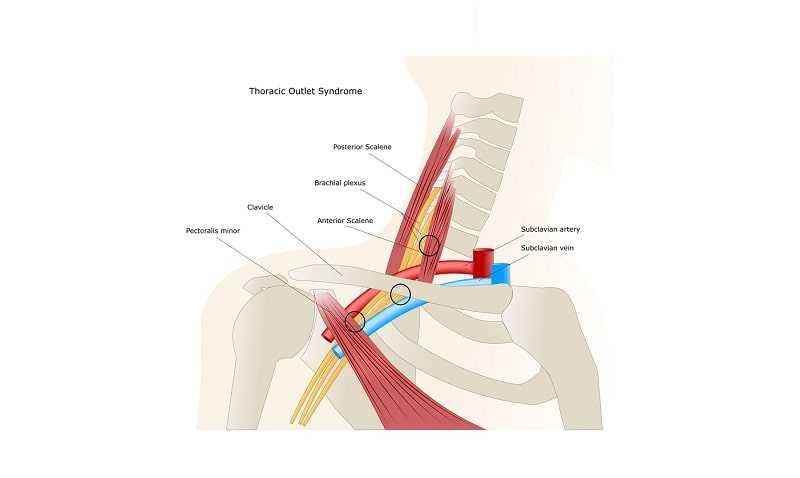Arterial Blockage in Legs

Leg Artery Blockage
Not all chronic pain of the legs is from arthritis or muscular disease. I have previously written on venous pain of the legs (click here to read), as well as other causes of leg pain.
This post will focus on arterial blockage of the legs and the chronic pain it causes.
Arterial blockage that happens suddenly is associated with dramatic symptoms.
In any location of the body, abrupt blockage of arterial blood flow is catastrophic to the organ system being supplied. A heart attack (called Acute Myocardial Infarction), Stroke (called Cerebrovascular Accident), and blood clot in the lung (called Pulmonary Embolism) are medical emergencies and require emergency attention.
Slower, more gradual obstruction of arterial blood flow can be subtle in its symptomatic presentation. In other words, the symptoms from chronic arterial blockage of the legs can be mistaken for other disorders.
The dysfunction that results from the gradual obstruction of an artery is not dramatic initially. Chronic pain of the legs can be caused by gradual arterial obstruction of in the legs.
Before we go any further, let’s review the anatomy and physiology of the arterial system of the legs.
A Brief Review of the Anatomy and Physiology of Arterial Disease of the Leg
The legs require enormous flow of oxygen rich blood when exercising. The flow of blood is less at rest and raises dramatically with exercise.
Muscle varies in its oxygen requirements, depending on whether it is actively contracting or not.
At rest, the blood flow requirement of leg tissue is substantially less and can be maintained even though there are severe blockages of the major arteries going into the legs. The pain of chronic arterial disease of the legs can be evoked with exercise.
The same patient without any leg pain at rest can have the pain provoked with exercise.
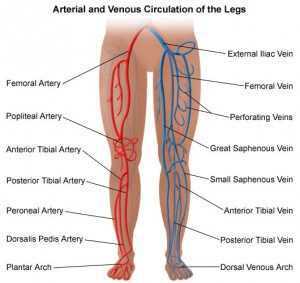
Gradual narrowing of the arteries through atherosclerotic disease is the most common cause of reduction in arterial blood flow.
The process is a slow one and may take years to develop. As the flow decreases the vascular system responds by creating collateral arteries that attempt to bypass the blocked areas naturally.
Collateralization does not restore the normal flow but is effective in forestalling death of tissue in the legs (until the atherosclerosis is very advanced). The amount of collateralization that occurs is dependent on several factors (such as genetics, gradual onset of the blockages, exercise habits of any given person, etc.).
What are the risk factors for developing these arterial blockages? We will discuss them in the next section.
What are the Risk Factors for Developing Arterial Blockage of the Legs?
The development of atherosclerosis with blockage is a combination of the forces that push cholesterol into the wall of an artery. There are also forces that make the wall of the artery “leak” so that cholesterol deposits more easily.
The absolute levels of cholesterol also influence the development of atherosclerosis. If you understand that these processes interact to cause the blockages, then you will understand why the risk factors work the way they do.
The following are the predominate risk factors in developing atherosclerosis of the lower legs (and elsewhere too):

- Tobacco smoking
- Hypertension
- Diabetes Mellitus
- Hypercholesterolemia
- Genetics
- Obesity
- Autoimmune Diseases
- Sedentary Lifestyles
- Radiation Exposure
- Environmental Toxins
- Chronic Stress States
- Hormonal Imbalance
There may be other risk factors but this list constitutes the majority of factors that increase the risk of developing atherosclerosis.
What are the Symptoms and Signs of Arterial Disease of the Leg?
As I have previously stated, arterial blockage can be subtle.
The most common symptoms that a person may develop are as follows:
- Painful cramping in your upper or lower leg muscles with or after activity. This is called Intermittent Claudication. It is usually relieved with a short rest.
- Leg numbness
- Leg weakness
- Coolness of the leg (especially when compared with the other leg).
- Sores of the toe, foot, or leg that will not heal.
- A change in the color of the skin of the leg.
- Slower hair growth on the lower legs (or even hair loss).
- Slow growth of toenails.
- Erectile Dysfunction
- Shiny skin of the legs
- A weak pulse or absent pulse of the legs.
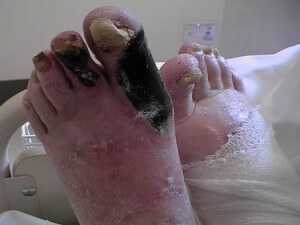
It is also of note that stroke and heart disease are associated with arterial blockage of the legs.
It stands to reason that blockages in one area of the body places you at risk for blockages elsewhere.
So how would this disorder be diagnosed? The next section will review this for you.
How is the Diagnosis of Arterial Blockage of the Legs Made?
I RECOMMEND THAT THE BEGINNING OF ANY PURSUIT FOR A DIAGNOSIS OF ARTERIAL BLOCKAGE OF THE LEGS BEGIN WITH A THOROUGH HISTORY AND PHYSICAL PERFORMED BY A LICENSED MEDICAL PRACTITIONER.
The history usually reveals one or more risk factors for development of this disease. Thereafter, pain with leg activity combined with many of the symptoms aforementioned will usually make the diagnosis.
Once the diagnosis of arterial blockage of the legs is considered it is easily confirmed.
However, the clinical diagnosis itself is not enough to establish a proper therapeutic plan. The next step after establishing a clinical diagnosis from a thorough history and physical is to have Doppler Ultrasound testing of the legs.
The Doppler Ultrasound (DU) is a non-invasive, painless way to identify whether there are blockages and to what degree. It will also tell you the location of the blockages in order that a complete picture is obtained.
It is performed by an Ultrasound technician as an outpatient procedure. DU is a device which emits a dense ultrasonic beam that is aimed at the locations of the arteries in the leg.
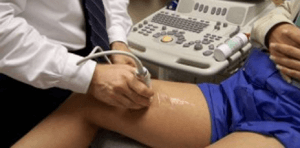
The information is recorded and interpreted by a physician trained in interpretation of the findings. Thereafter, most people will have a Vascular Surgery consultation for the best treatment plan recommendations.
The treatments are based on the severity of symptoms and the findings on the Doppler Ultrasound. I will review some basic treatment options in the next section.
What is the Treatment of Arterial Blockage of the Legs?
Treatment of arterial blockage of the legs symptoms is directed at the cause of the atherosclerosis as well as at relieving the blockages. All risk factors that can be reversed should be done so.
With documented arterial blockage, smoking must be immediately discontinued, blood pressure controlled, and blood sugar brought to normal.
The vascular surgeon will perform additional diagnostic testing that measures the actual blood flow reduction, location of the blockages, and the type of blockage. This will require measurement of blood pressure in your arm and ankle (called the ankle-brachial index or a/b index).
The blood flow to your ankle should be equal to or greater than your arm (an index of 1.0 – 1.4). Values below or above the normal range indicate an arterial vascular problem.
Once blockage has been thoroughly evaluated, the Vascular Surgeon will recommend whether intensive medical therapy or a surgical procedure is advisable. The underlying concept is to restore adequate blood flow to the involved leg.
Most vascular surgeries today involve a procedure called angioplasty. In this procedure the blocked or narrowed artery is opened with a balloon instrument in the operating room.
Because the blockages have a tendency to “spring back” after the procedure, a device called a stent is often left in place to keep the artery open.
Only the most severe blockages will require an open surgical procedure called vascular bypass (a topic for another article).
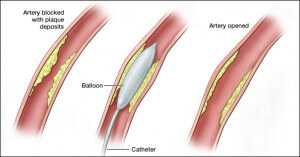
Overall, the therapies for arterial blockages are quite good and the outcomes are excellent for most people.
A return to painless use of the legs is the norm for most people.
Final Remarks
I have reviewed for you the anatomy, physiology, diagnosis, and treatment of arterial blockage of the legs. I hope you have found the information useful.
Chronic pain of the legs may be caused by this disorder and should be a consideration in anyone with intermittent claudication.
The preventative and direct blockage relieving therapies are very effective.
Most people who have this malady properly diagnosed at an early stage will have excellent results with relieving their pain.
THIS POST IS NOT TO BE CONSIDERED MEDICAL ADVICE BUT IS INFORMATIONAL ONLY.
If you have further questions or comments please leave it below.
Wishing you joy and healing.




